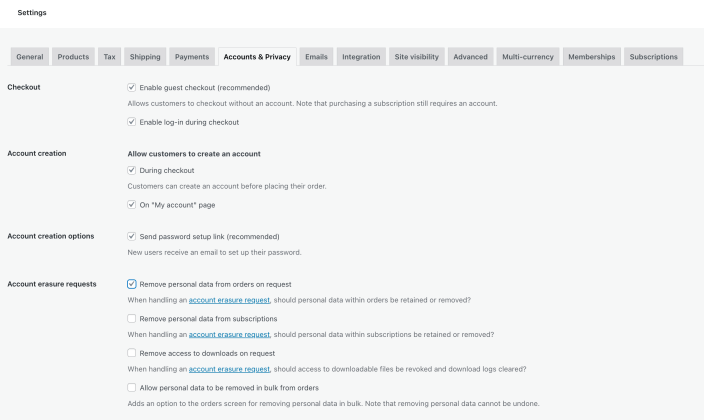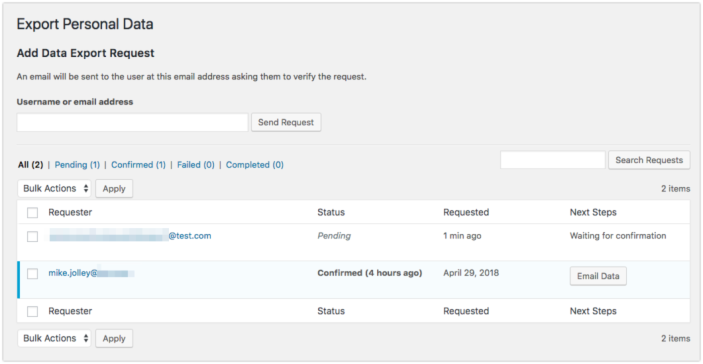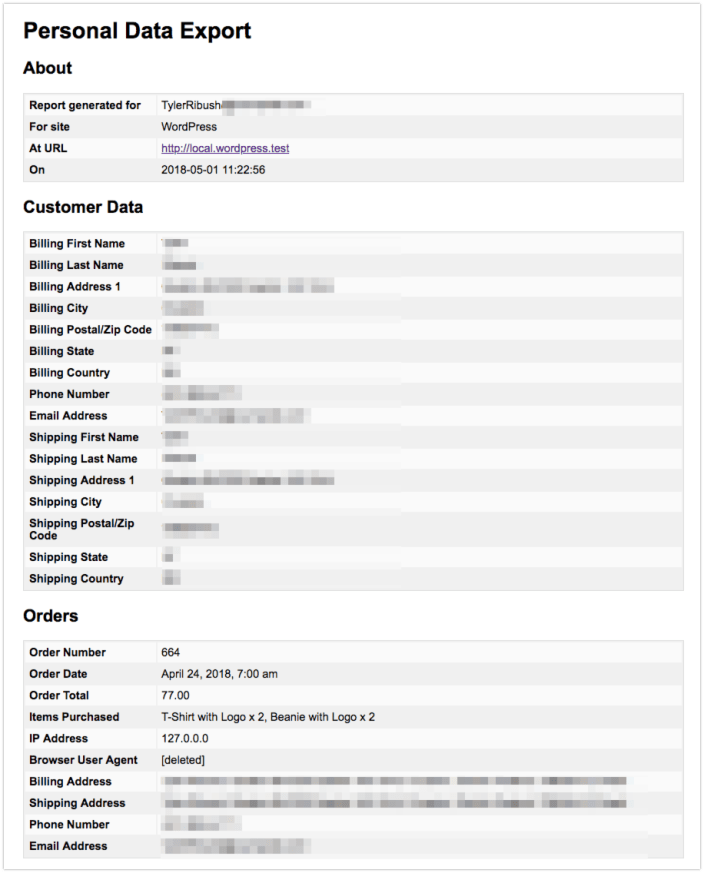Clicking on the Accounts and Privacy tab at the top of the WooCommerce > Settings page takes you to the accounts and privacy Settings.
These settings are where you can enable or disable guest checkout, control customer account creation, decide how personal data is retained or removed from your shop, and set your privacy policy notices. Sections include:
Additionally, we share information about what WooCommerce adds to the WordPress Personal Data Exporter tool.

Checkout and Accounts
↑ Back to topCheckout
- Enable Guest Checkout — Allows customers to check out without creating an account. Guest orders will not be tied to a user account in WordPress. It is important to keep in mind though that purchasing a subscription still requires an account.
- Enable log-in during checkout — Allows customers to log into an existing account during checkout and displays a login form and prompt on the checkout page if the customer is not already logged in.
Account Creation — Allow customers to create an account
- During Checkout — Customers can create an account before placing their order.
- Allow subscription customers to create an account during checkout (this will appear only if you are using WooCommerce Subscriptions) — when “During Checkout” is enabled please note that this option will not be available.
- On the “My Account” page.
Account creation options
- Send password setup link — New users receive an email to set up their password.
- Use email address as account login — If unchecked, customers will need to set a username during account creation. Note that if your site is using the block version of the cart and checkout, the “Use email address as account login” option is enabled and not shown. This is for compatibility reasons.
Account erasure requests
- Remove personal data from orders on request — When handling an account erasure request, should personal data within orders be retained or removed?
- Remove personal data from subscriptions (this will appear only if you are using WooCommerce Subscriptions)– When handling an account erasure request, should personal data within subscriptions be retained or removed?
- Remove access to downloads — When handling an account erasure request, should access to downloadable files be revoked and download logs cleared?
- Allow personal data to be removed in bulk from orders — Adds an option to the orders screen for removing personal data in bulk. Note that removing personal data cannot be undone.
Useful if you need to manually anonymize orders in bulk. See more about this feature at Managing Orders: Removing Personal Data from Orders.
Privacy policy
↑ Back to topThis section lets you select a page for your privacy policy, and display privacy policy snippets on your account and checkout pages shown to customers.

- Privacy Page — The link takes you to Settings > Privacy, where you can select a page to act as your privacy policy. Using
[privacy_policy]in the two notices below will link to this page. Some themes also use this option to link to a privacy policy in other places, such as the footer. - Registration privacy policy — Shown on the registration form on the My Account page. You should include information about your privacy policy, and link to your page privacy policy page for more information.
- Checkout privacy policy — Shown on the checkout form. You should include information about your privacy policy, and link to your page privacy policy page for more information.
Personal data retention
↑ Back to topThis section allows you to decide how long to keep order data on your store. You should specify how long your site will retain data in your privacy policy; consider what makes sense for local laws, such as the EU GDPR.

section within the WooCommerce “Accounts and Privacy” Settings.
For each option, enter a number and choose the duration from days, weeks, months, or years. Leaving these options blank will retain that data indefinitely.
- Retain inactive accounts — Inactive accounts are accounts which have not logged in nor placed an order for the specified duration.
- Retain pending orders — Pending orders are unpaid or abandoned and should not need to be fulfilled.
- Retain failed orders — Failed orders are unpaid or abandoned and should not need to be fulfilled.
- Retain cancelled orders — Cancelled orders were orders cancelled on purpose by either the admin or the customer, or timed out waiting for payment.
- Retain completed orders — Completed orders were fulfilled in the past.
- Retain ended subscriptions (will display only if you are using WooCommerce Subscriptions) — Retain Ended Subscriptions and their related orders for a specified duration before anonymizing the personal data within them.
If enabled, this cleanup will run via a daily cron job. Inactive accounts are tracked using anonymous metadata, and only subscriber/customer accounts are removed.
- Failed, pending, and canceled orders which get cleaned up will be moved to the trash.
- Completed orders which get cleaned up will be anonymized so sales stats are unaffected.
- Inactive accounts will be deleted. An inactive account is one which has not been logged in to, or which has not placed orders, for the specified time.
Personal Data Exporter
↑ Back to topWordPress 4.9.6 added the ability to export personal data associated with an email address to an HTML file. You can export personal data from your site at Tools > Export Personal Data. While these exports are not a WooCommerce feature, WooCommerce adds data to the generated export file, exporting the following data:
- Customer address/account information
- Orders associated with the given email address
- Download permissions and logs associated with the given email address

To ensure requests are genuine, a confirmation email is sent to verify the request. The verification process:
- Enter an email address or username.
- User is notified via email with a confirmation link.
- Confirmation link is used, and request is marked “confirmed.”
- Email with link to download their personal data is then sent to the user.
Here’s an example of a Personal Data File:

Questions and support
↑ Back to topDo you still have questions and need assistance?
This documentation is about the free, core WooCommerce plugin, for which support is provided in our community forums on WordPress.org. By searching this forum, you’ll often find that your question has been asked and answered before.
If you haven’t created a WordPress.org account to use the forums, here’s how.
- If you’re looking to extend the core functionality shown here, we recommend reviewing available extensions in the WooCommerce Marketplace.
- Need ongoing advanced support or a customization built for WooCommerce? Hire a Woo Agency Partner.
- Are you a developer building your own WooCommerce integration or extension? Check our Developer Resources.
If you weren’t able to find the information you need, please use the feedback thumbs below to let us know.
